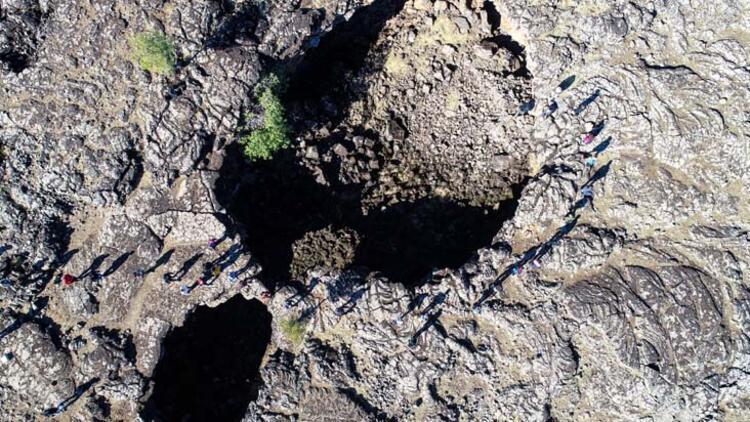
Residents of the southeastern provinces of Diyarbakır and Şanlıurfa want a region, which is considered to be the last place where the volcanic Mount Karaca outpoured lava, to turn into a geopark.
Located in Diyarbakır’s Çınar district, the area is among the favorite routes of nature enthusiasts with its different scenery, lava flow wrinkles, lava tunnels and caves formed under it.
Locals, non-governmental organizations and academics want the area to be transformed into a geopark and bring it into tourism.
Şefik İmamoğlu, an academic from Dicle University, said that the Mount Karaca volcanism was extremely fluid due to its basic character.
Noting that the mountain is the volcano with the largest floor area in the Mediterranean region, İmamoğlu stated that it carried out its last activity about 100,000 years ago.
İmamoğlu stated that the mountain, which started as a cleft eruption on the plains and took the shape of a shield in its early stages, covered an area of 10,000 square kilometers.
He also stressed that the area with lava flows can be brought into tourism.
Hacı Cebe, Diyarbakır Nature Sports Club’s manager, said there are hundreds of different beautiful caves under the rock masses formed by lava flows on the surface.
Explaining about one of the caves, which is called the “only bridge cave” by the villagers since there is a bridge-like arch at the top of the cave, Cebe said the cave was connected by tunnels, which could go up to 400 meters.
Cebe stated that the caves in this area should be examined by professional cavers.
“There is an area with similar surface shapes in [the Aegean province of] Manisa’s Kula district. It is not as large and wide as this area. A beautiful geopark was built there, and it was included in the UNESCO World Cultural Heritage List,” Cebe said, adding that he hopes that this area would be turned into a geopark as soon as possible.
Yeliz Çuban, a nature sports enthusiast, also stated that the terrain and caves in the region have a different structure.
“We and the authorities should do our best to bring this region into a geopark,” she said, noting that sightseeing tours might be organized for school students as well.
In 2006, Der Spiegel, a German daily, reported that the Max Planck Institute for Plant Breeding Research in Cologne had discovered that the genetically common ancestor of 68 contemporary types of cereal still grows as a wild plant on the slopes of Mount Karaca.
The results strongly suggest that slopes of the mountain provided the site for the first domestication of einkorn wheat nearly 9,000 years ago.